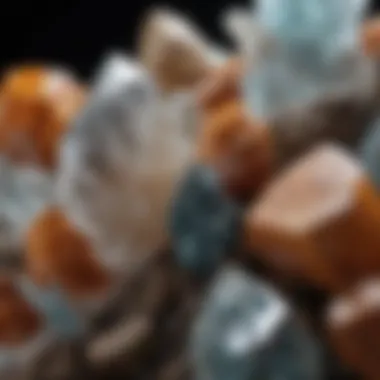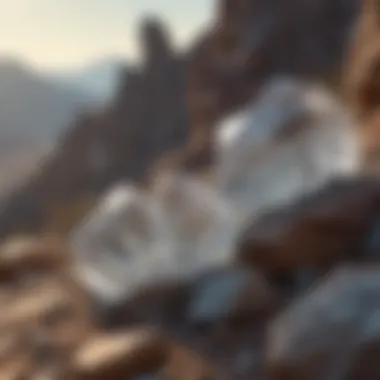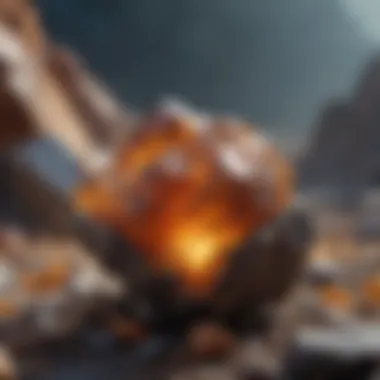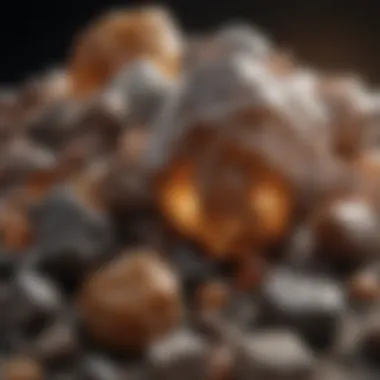Understanding Minerals: Their Role and Relevance


Intro
Minerals are more than mere geological formations; they are the fundamental blocks of our planet. With their crystalline structures, distinct properties, and various applications, they weave an intricate tapestry connecting our environment, technology, and even the arts. This article aims to unfold the vast and diverse world of minerals, shedding light on their rich history, significance, and classification, while also sharing practical tips on identification for collectors and enthusiasts alike.
From the ancient times where humans sought minerals for survival, crafting tools, and jewelry, to the modern age where minerals fuel industries and innovations, the relevance of this topic is undeniable. Each mineral tells a story, revealing clues about Earth's history and its processes. Whether you're navigating through a dusty rock shop or hunting for specimens in a pristine landscape, understanding minerals can enhance your experience enormously.
As we journey through the different facets of minerals, we shall explore their classifications and properties in depth. You will gain insights into their identification, making your collection not just a hobby but a passion enriched with knowledge. These elements shape our world, but they are also a reminder of the importance of sustainable practices in collecting.
To start off, let’s define precisely what constitutes a mineral.
Preface to Minerals
When we talk about minerals, we are opening the door to a fascinating world that is often overlooked but integral to our existence. Minerals are more than just shiny rocks; they represent the foundation of geology, chemistry, and even technology. This section serves as an introduction to the basic concepts of minerals, paving the way for a deeper understanding of their classifications, properties, and significance in various contexts.
Definition of Minerals
To grasp the subject, let's first pin down what minerals actually are. A mineral is a naturally occurring, inorganic solid with a definite chemical composition and a crystalline structure. To put it simply, minerals are the building blocks of rocks. Think of them as nature's little Lego pieces that form our planet's intricate structures. Minerals can be as diverse as the colors in a paint box, ranging from the familiar quartz, which could be clear or smoky, to the deep green of malachite. Each variety has a unique formula and characteristic properties that define its identity.
- For instance, quartz is mainly made of silicon dioxide and is known for its hardness and varied colors.
- On the other hand, calcite, with its composition of calcium carbonate, exhibits a fascinating double refraction property.
Importance of Studying Minerals
Understanding minerals is crucial for several reasons. Their study offers insight into Earth’s history, the environment, and even our own roles as inhabitants of this planet. Here are a few pivotal aspects to consider:
- Economic Value: Minerals play a significant role in industries such as construction, electronics, and energy. For example, lithium, a mineral, is essential for producing batteries that power our devices.
- Geological Insight: Studying minerals aids geologists in understanding processes like plate tectonics and volcanic activity. For example, the presence of specific minerals can indicate past environmental conditions and guide us in predicting natural events.
- Resource Management: As the demand for minerals increases, understanding their properties enables better resource management practices. This is key to ensuring sustainability and reducing the ecological impact of mineral extraction.
In summary, a comprehensive knowledge of minerals is not just about identifying rocks; it’s about appreciating their broader significance in shaping our world and benefiting our future.
Mineral Classification
Understanding mineral classification is crucial for anyone interested in the field of geology, especially for rock and fossil collectors. The classification systems provide a way to categorize minerals based on their chemical composition and crystal structure, which aids in identification and further study. This segment will covering the key categories of minerals and offer insights on their significance.
Silicate vs. Non-Silicate Minerals
Silicate minerals are the most abundant group on Earth, making up about 90% of the crust. They contain silicon and oxygen as their principal ingredients, typically in a tetrahedral arrangement, which forms the backbone of the mineral's structure. Examples include quartz and feldspar, which are often found in igneous and metamorphic rocks.
On the flip side, non-silicate minerals do not contain silicon-oxygen tetrahedra. Instead, they take on various forms, encompassing a wide variety of chemical compositions. They are further divided into groups like carbonates, sulfates, and oxides. Calcite, a primary component of limestone, is a well-known carbonate mineral.
Understanding the distinction is more than academic; it plays a vital role in practical applications, from mining to environmental science. By recognizing whether a mineral is silicate or non-silicate, one can infer its behavior and stability under different conditions.
Metallic and Non-Metallic Minerals
Metallic minerals are characterized by their shiny luster and good conductivity, usually containing elements like iron, copper, or aluminum. These minerals are typically extracted for their metal content and play a significant role in industrial applications such as construction, technology, and electronics. Hematite and galena are prime examples that showcase the metallic class.
In contrast, non-metallic minerals can be quite diverse. They are not typically used for their metal content but offer other valuable properties. Talc, widely known as the softest mineral, is utilized in talcum powder, while gypsum is used in the production of plaster. Knowing the difference between these two categories can guide collectors and industry professionals alike in identifying the best use for a mineral.
"Just because a mineral looks shiny doesn’t mean it’s metallic; it could just be quartz wearing a tuxedo."
Accessory Minerals
Accessory minerals, as the name suggests, are not the primary constituents of a rock but are still important in understanding its history and formation. These minerals typically appear in smaller amounts but can provide vital information regarding the conditions under which the rock was formed. For instance, zircon is an accessory mineral that can be used for dating the age of rocks, providing clues to the geological past.


Although accessory minerals might not dominate in abundance, their unique properties often lead to interesting discoveries. Many collectors specifically seek them out due to their rarity or the insights they infer about the geological environment.
Overall, mineral classification sets the foundation for all mineral studies. By recognizing and understanding these categories, one embarks on a journey through the Earth's crust, unlocking its secrets and understanding its composition.
Physical Properties of Minerals
Understanding the physical properties of minerals is paramount for anyone delving into the intricate world of geology and mineralogy. These properties not only aid in mineral identification but also provide insight into the conditions under which the minerals were formed. Being aware of these characteristics can significantly enhance a collector's appreciation and knowledge, enabling them to make informed decisions and choices.
Crystal Structure
The arrangement of atoms within a mineral gives it a unique crystal structure, setting it apart from other minerals. This orderly pattern influences various physical properties such as symmetry, angles, and external shapes. Different minerals can take on the same chemical composition yet exhibit vastly different crystal forms due to variations in their internal structures. For example, quartz crystals may appear six-sided, while calcite comes in various forms like rhombohedral or scalenohedral shapes.
This crystal lattice can showcase different forms of symmetry and hardness, showing an inherent beauty that charms collectors and geologists alike. Understanding your mineral's crystal structure not only educates you on its uniqueness but also hints at the environment where it was formed.
Color and Streak
Color is often the first physical property noticed when looking at a mineral, but it can be deceiving. Many minerals exhibit a variety of colors due to impurities or variations in their chemical composition. Take fluorite, for instance; it can appear in shades ranging from purple to green.
To better ascertain a mineral’s true characteristics, one can utilize the streak test. This involves rubbing the mineral against an unglazed porcelain tile to observe the color of the streak left behind. Interestingly, the streak color doesn't always match the mineral's external color. For example, hematite typically appears reddish-brown but leaves a red streak. Thus, conducting a streak test can sometimes unmask a mineral’s true identity, making it an invaluable tool for collectors.
Luster and Hardness
Luster describes how a mineral interacts with light, which can be categorized as metallic, vitreous, pearly, or dull, among others. This property can significantly influence a collector’s choice. For instance, the gleaming shine of galena makes it appealing, while sphalerite showcases remarkable variations in luster.
Complementing luster is the concept of hardness. The Mohs scale, ranging from 1 (talc) to 10 (diamond), provides a measure of a mineral's resistance to scratching. This is particularly useful when comparing samples; for instance, if a piece of quartz scratches glass, it signifies that quartz is harder than glass.
Understanding these properties aids in the identification process and enhances the appreciation of the mineral's beauty.
Cleavage and Fracture
Finally, the cleavage and fracture of minerals provide insight into their structural integrity. Cleavage refers to the tendency of a mineral to break along specific planes of weakness in its crystal structure, resulting in smooth surfaces. Minerals like muscovite break cleanly into thin sheets, making it easy to identify.
On the other hand, fracture describes the irregular breakage in minerals without any clear planes, often seen in minerals like quartz. The type of fracture can vary—conchoidal fractures resemble shells, while uneven fractures can be ragged. These characteristics are key identifiers during the mineral evaluation process.
"In the world of minerals, even the smallest detail has a story to tell. Understanding their physical properties leads to a deeper respect for the earth’s treasures."
Overall, grasping the physical properties of minerals isn’t just for academic sake; it opens the door to a richer collecting experience. Being informed about these features allows enthusiasts to connect more meaningfully with their collections, turning what might seem like simple rocks into examples of nature's artistry.
Geological Processes and Mineral Formation
Understanding geological processes is crucial for gaining insight into how minerals form, evolve, and are distributed across our planet. These processes encompass the dynamic forces of the earth—ranging from the molten magma beneath the crust to the pressures of tectonic movements. Each type of mineral emerges through a specific geological context, impacted by factors such as temperature, pressure, and the presence of water. By exploring these processes, collectors and enthusiasts not only enrich their knowledge but also enhance their ability to identify and appreciate the diversity of minerals they encounter.
Igneous Minerals
Igneous minerals form through the cooling and solidification of molten rock known as magma. This process can occur either beneath the earth’s surface, resulting in intrusive or plutonic rocks, or on the surface after a volcanic eruption, leading to extrusive or volcanic rocks. The texture of these minerals varies depending on the rate at which the magma cools. For instance, slow cooling allows larger crystal growth, leading to coarse-grained textures like those seen in granite, while rapid cooling results in fine-grained textures, common in basalt. Minerals such as quartz, feldspar, and mica are often primary constituents of igneous rocks.
Understanding the formation of these minerals aids collectors in knowing where to search for specific specimens and helps in identifying them based on their surroundings.
Metamorphic Minerals
Metamorphic minerals are generated from existing rocks—igneous, sedimentary, or even other metamorphic rocks—that undergo a transformation due to heat, pressure, and chemically active fluids. This metamorphosis can drastically alter the mineral composition and structure of the rock, often resulting in minerals that are not found in the original rock type. Examples include the transformation of limestone into marble, featuring calcite crystals, and shale evolving into schist with mica and garnet. The process of metamorphism also gives rise to unique textures, such as foliation and banding, which are highly valued by collectors for their aesthetic appeal.
Sedimentary Minerals


Sedimentary minerals emerge from the accumulation of sediment, which can be derived from the weathering and erosion of pre-existing rocks. These minerals often reflect past environmental conditions—clay minerals, for example, may indicate a period of calm water sedimentation, while quartz grains show the influence of wind erosion. The sedimentation process culminates in layers that can become compacted and cemented over time, yielding rocks such as sandstone and limestone. Minerals like halite and gypsum, formed through evaporation of saline water, are also classical examples of sedimentary origin. Understanding these formations is not only key to identifying minerals but also aids collectors in predicting potential locations where specific specimens may be found.
Minerals in Society
The relevance of minerals in our daily lives cannot be overstated. Their role transcends mere geological curiosity and weaves seamlessly into the fabric of economic stability, health care, and technological advancements. Each mineral has its own unique story and utility, contributing to society in ways that often go unnoticed. Understanding this connection helps enthusiasts and collectors appreciate not just the beauty of these natural wonders but also their real-world implications.
Economic Importance of Minerals
Minerals serve as the backbone of numerous industries. A spotlight on the economic significance reveals not only their extraction value but their essential role in manufacturing and infrastructure development. For instance, iron ore and copper, when mined and processed, become integral to the construction of roads, bridges, and buildings.
Here are a few key aspects to consider regarding the economic importance of minerals:
- Job Creation: The mining and minerals sector is a substantial source of employment worldwide, directly and indirectly.
- Trade and Exports: Countries rich in mineral resources, such as Brazil with its iron ore or South Africa with platinum, rely heavily on exporting these minerals to sustain their economies.
- Investment Opportunities: Mineral exploration can attract investment, leading to economic growth in underdeveloped areas.
"Minerals are not just rocks but building blocks of civilization, shaping our economies and landscapes alike."
In addition, the supply chain for minerals injects life into local economies, often resulting in better infrastructure and enhanced public services, which can significantly improve living standards in these regions.
Medicinal Applications
Beyond the realm of construction and industry, there lies an intriguing aspect of minerals—their application in medicine. Various minerals play vital roles in modern therapies and health-related products.
Think of how minerals like calcium and magnesium are essential for overall health. They not only promote bone density but also participate in various cellular processes. Some minerals have taken center stage in alternative medicine practices too.
- Zinc: Often hailed for its immune-boosting properties, zinc is pivotal in healing wounds and maintaining health during illness.
- Selenium: Recognized for its antioxidant properties, selenium supplements are utilized in cancer prevention strategies.
- Lithium: Emerging research suggests that lithium can aid in the management of mood disorders, making it a topic of great interest in psychiatric medicine.
Thus, they not only enhance physical well-being but also open doors to innovative health treatments.
Minerals in Technology
The modern technological landscape owes much to the quiet yet profound influence of minerals. Our smartphones, electric vehicles, and renewable energy solutions rely heavily on a plethora of minerals, underscoring their importance in driving innovation.
- Rare Earth Elements: Neodymium and dysprosium are key in manufacturing high-performance magnets used in electric motors and wind turbines.
- Lithium: Dominantly used in batteries, lithium has surged in importance with the rise of electric vehicles, showcasing its pivotal role in transitioning to sustainable energy.
- Silicon: The cornerstone of the tech industry, silicon is critical for semiconductors, used in virtually every electronic device.
Thus, the collective impacts of minerals manifest in various forms, pushing boundaries in technology and sustainability.
Mineral Identification Techniques
Understanding how to identify minerals is crucial for both collectors and enthusiasts as it allows for proper classification and appreciation of these natural wonders. The world of minerals is vast, and being able to discern one mineral from another can reveal much about a specimen's origins and characteristics. Proper identification techniques not only elevate the experience of collecting but also contribute to scientific understanding and conservation efforts. Knowledge of the various identification techniques can enhance one's observational skills and foster a deeper connection with the mineral world.
Visual Identification
Visual identification is often the first step in recognizing minerals, but it demands a keen eye and an understanding of key characteristics. When examining a mineral, collectors should pay attention to the following:
- Color: Though not entirely reliable, color can be a helpful initial clue. Some minerals come in a variety of colors; for example, quartz can be clear, purple, or even smoky.
- Streak: The color of a mineral's powder, obtained by rubbing the mineral on a porcelain plate, can provide insight into its true color and is less affected by surface impurities.
- Crystal form: The external shape of a crystal, including its symmetry and clarity, can indicate what type of mineral it is.
- Habit: The general appearance of the mineral, such as whether it’s fibrous or granular, can also suggest its identity.
Many enthusiasts carry a small field guide to help them identify minerals based on these visual cues, assisting in distinguishing similar-looking specimens.
Chemical Tests
Chemical tests offer a deeper understanding of a mineral's identity by examining its chemical properties. These tests are often more accurate than visual methods. Common tests include:


- Acid test: Applying a few drops of hydrochloric acid can show effervescence in carbonates, such as calcite, indicating the presence of calcium carbonate.
- Hardness test: Using the Mohs scale, which ranges from talc at 1 to diamond at 10, collectors can scratch the mineral against common objects like glass or a fingernail to assess its hardness.
- Magnetism: Some minerals, such as magnetite, may respond to a magnet and can be identified accordingly.
These tests can be conducted effectively with minimal equipment, making them accessible for collectors in the field.
Microscopic Examination
Microscopic examination is an advanced method of mineral identification, essential for discriminating between similar-looking minerals at a microscopic scale. A polarizing microscope can reveal crucial details like:
- Birefringence: Different minerals will display varying degrees of light refraction under polarized light, helping to separate them.
- Inclusion: Examining inclusions or impurities within a mineral can provide vital information about its growth history and environment.
- Grain texture: Observing texture at this level helps in understanding the formation conditions of the mineral.
This method requires more sophisticated equipment and knowledge but can uncover the unique features that set minerals apart from one another.
"In the world of minerals, every detail counts. A careful eye and a methodical approach can reveal the history trapped within each specimen."
By utilizing a combination of these identification techniques, collectors can enhance their understanding and appreciation of minerals. Familiarity with these methods fosters not only personal growth in the field but also contributes to the larger narrative of mineralogy, ecology, and heritage.
Responsible Mineral Collection
The practice of mineral collection is one that can be both rewarding and complex. It’s not merely about gathering shiny rocks or fascinating fossils; it entails a whole spectrum of responsibilities towards the environment, legal regulations, and ethical standards. Understanding these layers is key for any collector who wishes to engage meaningfully with the world of minerals.
Ethics of Collecting
At the core of responsible mineral collection lies ethics. Collectors must grapple with the question of ownership—who has the right to collect minerals from specific locations? Respecting the land and its native cultural significance is paramount. Many sites, such as national parks or indigenous lands, hold minerals that should not be disturbed. For instance, taking a specimen from a culturally sensitive area can cause both environmental disruption and social unrest. Understanding this dynamic is crucial for any collector.
Adopting ethical practices also means considering the impact of one's actions on local ecosystems. Collectors need to be aware that indiscriminate collection can lead to habitat destruction and loss of biodiversity. Therefore, utilizing sustainable methods is not just a guideline, but a necessity. For instance, if you're lucky enough to collect quartz crystals from a private property, you might consider leaving the surrounding vegetation undisturbed as much as possible, ensuring that local wildlife can thrive.
Moreover, many clubs and organizations promote ethical collecting. Joining these groups can offer support and guidelines on best practices that align with ethical standards. Perhaps you could explore options available at sites like reddit.com, where collectors often share tips on ethical practices.
Legal Considerations
Legal frameworks also play a significant role in shaping responsible mineral collection. Laws vary widely depending on the jurisdiction, so it's imperative for collectors to do their homework before heading out to gather specimens. Engaging in mineral collecting without proper permissions can lead to legal troubles that one would rather avoid.
In many countries, certain regions have strict regulations governing what can be collected and how. For example, in the United States, collecting minerals in national forests or public lands requires a permit in many cases. Failure to adhere to these regulations can result in hefty fines and damage to one’s reputation as a responsible collector. It's essential to check with local authorities and acquire the necessary permits before embarking on a collection expedition.
In addition to government rules, private landowners maintain their own regulations concerning mineral collection on their property. Always obtain explicit permission. A friendly conversation can go a long way and sometimes lead to unexpected collecting opportunities—perhaps a previously undiscovered monocline on the property.
Legal issues may also arise regarding the sale of minerals. Selling minerals collected from restricted areas without proper documentation can not only impact your wallet but also the validity of your collection.
"In the world of minerals, knowledge isn't just power; it's a responsibility."
This underlines why understanding and adhering to the ethical and legal aspects of mineral collecting is essential for anyone serious about the hobby. By doing so, collectors not only safeguard their interests but also foster a sustainable relationship with the natural world.
Finale
In wrapping up our exploration into the world of minerals, it’s vital to appreciate the intricate tapestry they weave into our lives. From the sparkly quartz in our jewelry to the essential elements hidden within the Earth, minerals are not just rocks we collect; they form the backbone of various industries, technology, and even our health.
Understanding the key concepts related to minerals provides an invaluable perspective both as collectors and as stewards of the natural world. The connections laid out throughout this article emphasize how every mineral tells a story—not just of the Earth’s history but also of its ongoing relevance to modern society. For instance, the economic implications tied to mineral industries underscore their weight in our daily lives; this brings attention to sustainable practices, ensuring we leave a positive legacy for future generations.
Engaging with minerals elevates our awareness of ethical collecting practices too. Enthusiasts must navigate the fine line between passion and responsibility, ensuring that practices do not detrimentally affect the ecosystems from which these treasures are sourced. Understanding legal regulations surrounding mineral collection plays a crucial part in this journey, thus safeguarding not just the mineral deposits but also the environment as a whole.
The takeaway here is multi-layered. It’s about
- realizing the beauty inherent in minerals,
- understanding their classifications,
- acknowledging their properties, and
- appreciating their roles in society.
By synthesizing the information covered, mineral collectors can not only enhance their personal collections but also become more conscientious participants in the larger dialogue about mineral usage and conservation.
"All that glitters is not gold, yet the stories behind each mineral can reveal priceless truths."
In the end, every rock and crystal carries with it an essence of wonder and insight, waiting for us to unravel its secrets through informed engagement as stewards of our planet.



